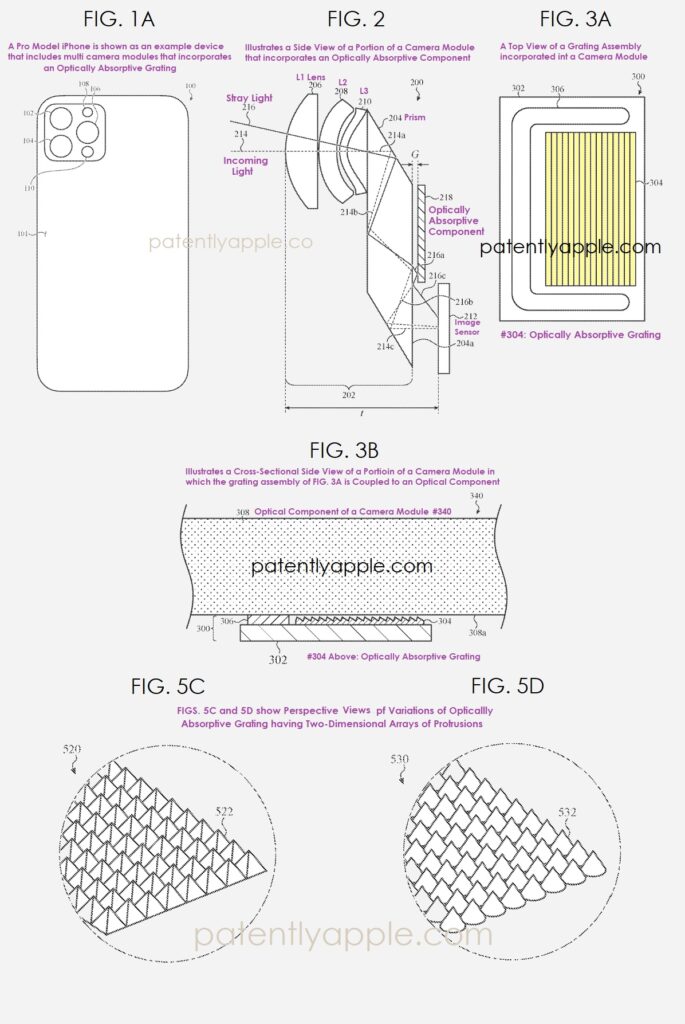Apple appears to be making progress toward addressing a long-standing issue with iPhone cameras: lens flare. A recent patent application from the U.S. Patent and Trademark Office showcases Apple’s creative strategy to tackle this problem by incorporating micro-scale optically absorptive gratings in future camera modules, likely for the next iPhone Pro models.
Lens flare, which manifests as unwanted light artifacts when photographing bright light sources, particularly at night, has been a persistent concern for iPhone users. Discussions about this optical phenomenon have been prevalent in online forums, Reddit discussions, and technology reviews, with many users finding it distracting and difficult to correct, even during post-processing.
A report from Dogcow-Moof in 2021 highlighted numerous flare occurrences across various iPhone models. In 2024, a leaker named Yeux1122 suggested that Apple was experimenting with a new coating to minimize flare, sparking rumors that the iPhone 16 Pro would feature this improvement. However, when the flagship device was released, users, including one on MacRumors Forums, reported that the issue was still present.
Now, Apple’s recent patent application indicates that the company is still committed to solving this problem.
Inside the Patent: Micro-Scale Gratings to Absorb Stray Light
The new patent emphasizes a camera module design that incorporates optically absorptive gratings to minimize or eliminate stray light from entering the camera system, light that could otherwise lead to flare.
The system consists of:
- An image sensor
- An optical assembly (such as a lens or prism)
- A grating assembly attached to the optical component, featuring a substrate and a layer of absorptive gratings
These micro-scale gratings are small structures, often resembling pyramids, cones, or triangular peaks, which can be arranged in one-dimensional or two-dimensional patterns. Their main function is to absorb light rays that approach at problematic angles, preventing them from reflecting within the lens and causing flare.
In one setup, an optical element, like a prism, is positioned apart from the grating by an air gap, with the grating mounted on a transparent substrate that has an absorptive coating. Light that enters the optical path is reflected within the prism through total internal reflection, while the nearby absorptive grating helps eliminate unwanted reflections.
Each protrusion in the array stands at a minimum height of 15 microns, and these structures are designed to disrupt and absorb specific wavelengths and angles of incoming light, acting like traps for photons that cause flares.

Will it come to the iPhone 17 Pro?
Although the patent does not specify its use in any particular iPhone model, the technology fits well with Apple’s ongoing mission to enhance mobile photography and videography, especially for its Pro series. With the iPhone 16 Pro not addressing lens flare issues despite widespread speculation, there is optimism that this new technology could be introduced in the iPhone 17 Pro or future Apple Vision or iPad Pro devices.
What It Means for Users
If adopted, this innovation could greatly improve image quality in difficult lighting situations, particularly for night photography, urban videography, and cinematic effects. It also indicates that Apple is exploring micro-structural engineering solutions rather than relying solely on coatings or software adjustments to tackle a challenging issue.
While Apple has yet to comment on the patent, the filing showcases the company’s commitment to enhancing iPhone camera capabilities and user satisfaction.
Final Thoughts
Currently just a patent, Apple’s recent filing strongly suggests that a hardware solution for lens flare may soon be on the way. For photographers, videographers, and everyday users who are tired of unwanted glowing spots in their images, this advancement could be the long-awaited upgrade they have been looking for.
For more daily updates, please visit our News Section.

